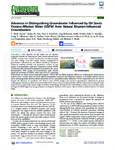Advances in Distinguishing Groundwater Influenced by Oil Sands Process-Affected Water (OSPW) from Natural Bitumen-Influenced Groundwaters.
| dc.contributor.author | Hewitt, LM | en |
| dc.contributor.author | Roy, JW | en |
| dc.contributor.author | Rowland, SJ | en |
| dc.contributor.author | Bickerton, G | en |
| dc.contributor.author | DeSilva, A | en |
| dc.contributor.author | Headley, JV | en |
| dc.contributor.author | Milestone, CB | en |
| dc.contributor.author | Scarlett, AG | en |
| dc.contributor.author | Brown, S | en |
| dc.contributor.author | Spencer, C | en |
| dc.contributor.author | West, CE | en |
| dc.contributor.author | Peru, KM | en |
| dc.contributor.author | Grapentine, L | en |
| dc.contributor.author | Ahad, JME | en |
| dc.contributor.author | Pakdel, H | en |
| dc.contributor.author | Frank, RA | en |
| dc.date.accessioned | 2020-08-25T14:42:11Z | |
| dc.date.available | 2020-08-25T14:42:11Z | |
| dc.date.issued | 2020-02-04 | en |
| dc.identifier.uri | http://hdl.handle.net/10026.1/16193 | |
| dc.description.abstract |
The objective of this study was to advance analytical methods for detecting oil sands process-affected water (OSPW) seepage from mining containments and discriminating any such seepage from the natural bitumen background in groundwaters influenced by the Alberta McMurray formation. Improved sampling methods and quantitative analyses of two groups of monoaromatic acids were employed to analyze OSPW and bitumen-affected natural background groundwaters for source discrimination. Both groups of monoaromatic acids showed significant enrichment in OSPW, while ratios of O2/O4 containing heteroatomic ion classes of acid extractable organics (AEOs) did not exhibit diagnostic differences. Evaluating the monoaromatic acids to track a known plume of OSPW-affected groundwater confirmed their diagnostic abilities. A secondary objective was to assess anthropogenically derived artificial sweeteners and per- and polyfluoroalkyl substances (PFAS) as potential tracers for OSPW. Despite the discovery of acesulfame and PFAS in most OSPW samples, trace levels in groundwaters influenced by general anthropogenic activities preclude them as individual robust tracers. However, their inclusion with the other metrics employed in this study served to augment the tiered, weight of evidence methodology developed. This methodology was then used to confirm earlier findings of OSPW migrations into groundwater reaching the Athabasca River system adjacent to the reclaimed pond at Tar Island Dyke. | en |
| dc.format.extent | 1522 - 1532 | en |
| dc.language | eng | en |
| dc.language.iso | eng | en |
| dc.rights | Attribution-NonCommercial-NoDerivatives 4.0 International | en |
| dc.rights | Attribution-NonCommercial-NoDerivatives 4.0 International | en |
| dc.rights.uri | http://creativecommons.org/licenses/by-nc-nd/4.0/ | en |
| dc.rights.uri | http://creativecommons.org/licenses/by-nc-nd/4.0/ | en |
| dc.subject | Alberta | en |
| dc.subject | Carboxylic Acids | en |
| dc.subject | Groundwater | en |
| dc.subject | Hydrocarbons | en |
| dc.subject | Oil and Gas Fields | en |
| dc.subject | Sand | en |
| dc.subject | Water Pollutants, Chemical | en |
| dc.title | Advances in Distinguishing Groundwater Influenced by Oil Sands Process-Affected Water (OSPW) from Natural Bitumen-Influenced Groundwaters. | en |
| dc.type | Journal Article | |
| plymouth.author-url | https://www.ncbi.nlm.nih.gov/pubmed/31906621 | en |
| plymouth.issue | 3 | en |
| plymouth.volume | 54 | en |
| plymouth.publication-status | Published | en |
| plymouth.journal | Environ Sci Technol | en |
| dc.identifier.doi | 10.1021/acs.est.9b05040 | en |
| plymouth.organisational-group | /Plymouth | |
| plymouth.organisational-group | /Plymouth/Faculty of Science and Engineering | |
| plymouth.organisational-group | /Plymouth/Research Groups | |
| plymouth.organisational-group | /Plymouth/Research Groups/Marine Institute | |
| plymouth.organisational-group | /Plymouth/Users by role | |
| dc.publisher.place | United States | en |
| dc.identifier.eissn | 1520-5851 | en |
| dc.rights.embargoperiod | Not known | en |
| rioxxterms.versionofrecord | 10.1021/acs.est.9b05040 | en |
| rioxxterms.licenseref.uri | http://creativecommons.org/licenses/by-nc-nd/4.0/ | en |
| rioxxterms.type | Journal Article/Review | en |



